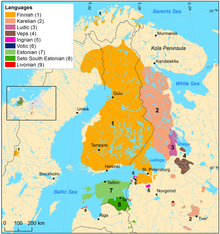 Finnic languages at the beginning of the 20th century | |
| Total population | |
|---|---|
| c. 7.4–8.2 million | |
| Regions with significant populations | |
| Finns[a] | c. 6.2–7 million |
| Estonians | c. 1.1 million |
| Karelians | c. 43,000[1][2] |
| Vepsians | c. 4,800[3] |
| Izhorians | c. 1,000 |
| Livonians | c. 430-610 |
| Votes | c. 100 |
| Languages | |
| Finnic languages | |
| Religion | |
| Predominantly Christianity (either Lutheranism or Eastern Orthodoxy);[4] minority Uralic Neopaganism | |
| Related ethnic groups | |
| Other Finno-Ugric peoples | |
a Tornedalians, Ingrians, Kvens and Forest Finns are subsumed under Finns, as they are most commonly described as being subgroups of Finns proper rather than separate ethnic groups altogether. | |
The Baltic Finnic peoples, often simply referred to as the Finnic peoples,[a] are the peoples inhabiting the Baltic Sea region in Northern and Eastern Europe who speak Finnic languages. They include the Finns, Estonians (including Võros and Setos), Karelians (including Ludes and Livvi), Veps, Izhorians, Votes, and Livonians. In some cases the Kvens, Ingrians, Tornedalians and speakers of Meänkieli are considered separate from the Finns.
The bulk of the Finnic peoples (more than 98%) are ethnic Finns and Estonians, who reside in the two independent Finnic nation states—Finland and Estonia.[5]
Finnic peoples are also significant minority groups in neighbouring countries of Sweden, Norway and Russia, especially Karelia.
- ^ "Росстат — Всероссийская перепись населения 2020". rosstat.gov.ru. Retrieved 3 January 2023.
- ^ Languages of Finland. "Finland". Ethnologue.com. Retrieved 12 March 2017.
- ^ Russian census 2010 Archived 6 October 2014 at the Wayback Machine
- ^ "Population". Statistics Finland. Archived from the original on 10 October 2018. Retrieved 3 May 2016.
- ^ "Finnic peoples". Encyclopædia Britannica Online. Encyclopædia Britannica, Inc. Archived from the original on 5 September 2015. Retrieved 6 February 2019.
Cite error: There are <ref group=lower-alpha> tags or {{efn}} templates on this page, but the references will not show without a {{reflist|group=lower-alpha}} template or {{notelist}} template (see the help page).